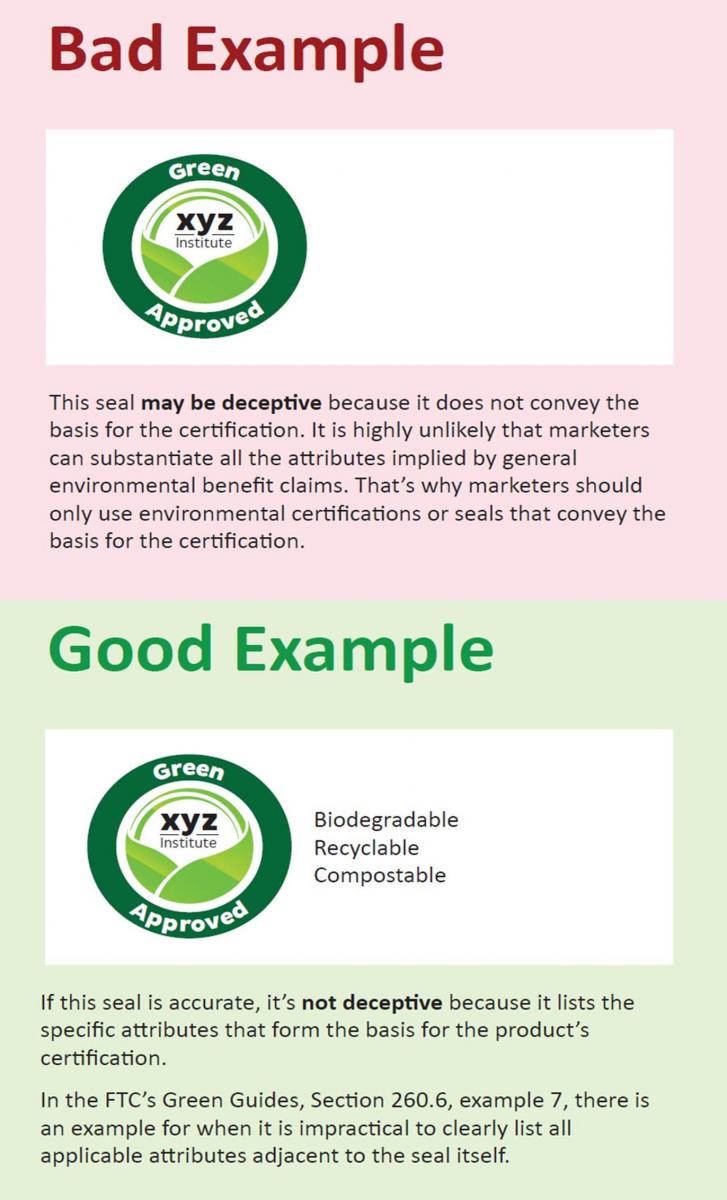You don’t need to go to a water park to see performing seals. You can spot them on websites where they perform the function of conveying information about the purported environmental benefits of products. But do the groups offering those seals – and the companies that display them – have appropriate proof for the claims consumers take from them? If your clients use environmental seals or certifications, you’ll want to see the latest from the FTC staff.
Revised in 2012, the FTC's Green Guides discuss the use of certifications and seals of approval. FTC staff just sent warning letters to five groups that offer environmental certifications and 32 businesses that display them. You'll want to review the letters for important details and citations, but here are some key principles to keep in mind.
Without careful qualification, general environmental benefit claims pose a risk of deception. General certifications can convey a wide range of meaning to consumers, including that a product has specific and far-reaching environmental benefits and that a product has no negative environmental impact. The staff letters quote a word of warning from the Green Guides: “Because it is highly unlikely that marketers can substantiate all reasonable interpretations of these claims, marketers should not make unqualified general environmental benefit claims.”
 Certifications and seals that don’t explain the reason for the thumbs-up may convey broad claims that can’t be substantiated. According to the Green Guides, a certification or seal that doesn’t explain its underlying basis “likely conveys that the product offers a general environmental benefit.” To quote Warren Zevon, consider “Mr. Bad Example” on the right. It makes a broad “Green Approved” claim, but doesn’t explain the grounds for the seal. Unless you can substantiate all of the attributes implied by the general environmental benefit claim – not an easy thing to do – “marketers should not use environmental certifications or seals that do not convey the basis for the certification.”
Certifications and seals that don’t explain the reason for the thumbs-up may convey broad claims that can’t be substantiated. According to the Green Guides, a certification or seal that doesn’t explain its underlying basis “likely conveys that the product offers a general environmental benefit.” To quote Warren Zevon, consider “Mr. Bad Example” on the right. It makes a broad “Green Approved” claim, but doesn’t explain the grounds for the seal. Unless you can substantiate all of the attributes implied by the general environmental benefit claim – not an easy thing to do – “marketers should not use environmental certifications or seals that do not convey the basis for the certification.”
Companies can take steps to reduce the risk of deception. If consumers are likely to interpret general certifications and seals broadly, what can marketers do to clarify their claims? The Green Guides suggest accompanying the visual with “clear and prominent qualifying language that clearly conveys that the certification or seal refers only to specific and limited benefits.” In addition to hypotheticals discussed in the Guides, the second example on the right shows how that might be done. There, the “Green Approved” seal includes the words "Biodegradable, Recyclable, Compostable" – giving specificity to the company’s claims. Of course, the company would still need appropriate proof to support those representations, but listing the specific attributes that form the basis of the product’s certification may reduce the risk of deception.
Logos themselves aren’t likely to be effective hyperlinks. Suppose advertisers wants to provide more information to put the certification or seal in context for consumers. They shouldn’t assume people will simply click on an icon for an explanation. Because consumers may view the visual as just another graphic on the page, “a symbol or icon might not provide sufficient clues about why a claim is qualified or the nature of the disclosure.” What’s the best way to convey explanatory information? Make it big. Make it easy to understand. Make it close to the claim it qualifies. As the warning letters indicate, that’s straight from the FTC’s staff guidance publication, .com Disclosures: How to Make Effective Disclosures in Digital Advertising. But in limited circumstances where not all applicable attributes can listed right next to the seal, a clear and prominent hyperlink may help – but be sure to give sufficient information upfront and explain why it’s important to click on the link. The Green Guides cover this narrow situation in Example 7 of Section 260.6 and .com Disclosures offers guidance, too.
Both the certifier and the advertiser have responsibilities under Section 5 of the FTC Act. Why did the FTC staff send letters to certifiers and to marketers that display their seals? Because both groups have responsibilities for avoiding misleading claims. For example, as the letter to certifiers notes, “Although your website provides information to marketers regarding your logo’s use, it does not appear to instruct marketers to use qualifying language.” If your clients issue seals or display them, is it time for a compliance check?
The FTC has resources for companies that want to keep green claims clean. Filled with real-world examples, the Green Guides were written with busy executives in mind. If you haven’t read them in a while, a refresher may be in order. Interested in a deeper dive? As the warning letters remind companies, the Green Guides’ Statement of Basis and Purpose includes detailed information. Bookmark the Business Center’s Environmental Marketing page for free multimedia resources.
The FTC staff hasn’t made an official determination that recipients’ environmental claims violate the law. However, given staff’s concerns, the letters to certifiers asks them to get back to us about “the steps you are taking to ensure that marketers displaying your certification are in compliance.” We also asked advertisers who got the letters to let us know what they’re doing “to bring [their] marketing into compliance.”
